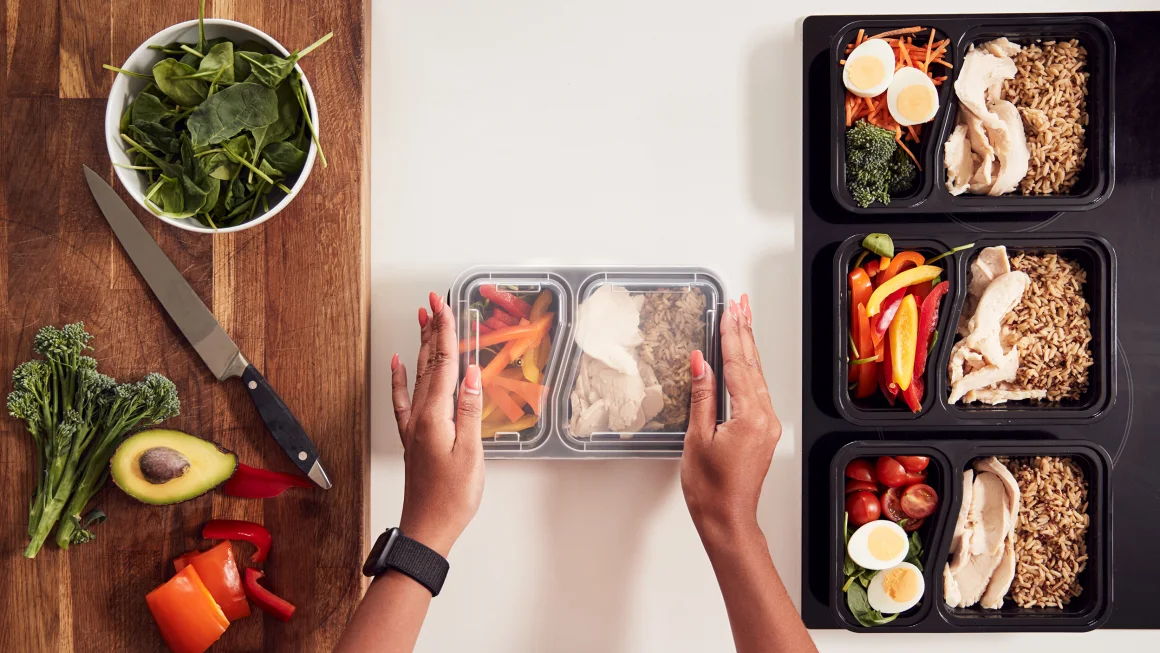Meal Prep Container Ideas Meal prepping has revolutionized how people approach daily meals, saving time, reducing stress, and promoting healthier eating habits. A key factor in successful meal prepping is choosing the right containers, ensuring food stays fresh, organized, and easy to transport. In this guide, we explore some of the best meal prep container ideas, tips for choosing suitable materials, and ideas for a meal prep-friendly lifestyle.

Why Meal Prep Containers Matter
Containers are an essential part of meal prep as they preserve food freshness, ensure portability, and can even help with portion control. A great container setup can enhance the quality of your food and make the process more enjoyable and efficient. Choosing the right containers also has environmental and health benefits, as it can reduce single-use plastics and allow for safer storage.
For example, using glass containers helps to avoid any chemical leaching that can occur with some plastics, especially when reheating.
Key Factors to Consider When Choosing Meal Prep Containers
To find the perfect meal prep containers, consider the following aspects:
- Material: Glass, BPA-free plastic, and stainless steel are popular choices. Each material has pros and cons:
- Glass Containers are microwave and oven-safe, don’t retain food odors, and are environmentally friendly.
- Plastic Containers are lightweight and less breakable, making them ideal for on-the-go meals, but opt for BPA-free options.
- Stainless Steel Containers are durable and great for storing dry goods, though they aren’t always microwave-safe.
- Size and Compartments: Choose containers that fit your meal types. For example:
- Single-compartment containers are ideal for simple meals, like salads or pasta dishes.
- Multi-compartment containers work well for meals that have different components, such as proteins, grains, and vegetables.
- Leakproof and Airtight Features: To prevent spills and keep food fresh, airtight and leakproof lids are essential, especially for dishes with sauces or dressings.
- Stackability and Storage: Stackable containers make it easy to organize meals in the fridge and save space. Look for containers with nestable designs to save room when not in use.
Best Meal Prep Containers for Every Need
- For Soups and Sauces:
Mason jars or round, airtight containers work well for storing liquids. Glass jars keep soups fresh and allow for easy reheating. - For Salads and Grain Bowls:
Use compartmentalized containers that separate greens, grains, proteins, and dressings. This setup keeps greens fresh and prevents sogginess. - For Overnight Oats or Yogurt Parfaits:
Small glass jars or reusable plastic containers are perfect for individual servings. They keep ingredients layered and fresh. - For Snacks and Small Bites:
Bento-style boxes are excellent for snack-sized portions and portion control. Look for containers with small compartments for items like nuts, cheese, fruits, and crackers. - For Freezing and Storing Bulk Meals:
Freezer-safe containers are a must if you prep meals in advance. Opt for containers with high durability to prevent cracking from freezing temperatures.
How to Organize Your Meal Prep Containers Efficiently
Proper organization makes meal prepping smooth and stress-free. Here are some tips:
- Label Containers with meal names and dates to avoid confusion and ensure freshness. Reusable stickers or erasable markers work well for this purpose.
- Stack Similar Types Together for easy access. Stack single-compartment containers in one area and compartmentalized containers in another.
- Use a Dedicated Meal Prep Shelf in the fridge or pantry, if possible, to keep all meals in one place, streamlining the process.
Meal Prep Container Ideas for Specific Diets
Whether following a plant-based diet, keto, or a high-protein regimen, containers can help maintain a balanced meal plan:
- For Plant-Based Diets:
Containers with ample space for grains, vegetables, and legumes are perfect. Glass containers are ideal for storing cooked vegetables and beans as they retain freshness. - For Keto Diets:
Focus on containers that allow you to portion proteins, healthy fats, and low-carb vegetables. Airtight glass containers keep avocados, nuts, and cheeses fresh. - For High-Protein Diets:
Choose larger containers that can accommodate protein sources like chicken, fish, or tofu. Stainless steel containers work well for storing grilled meats or roasted vegetables. - For Families or Large Batches:
Large, freezer-safe containers make it easy to prepare meals in bulk for family-sized portions.
Sustainable Meal Prep Container Options
Eco-conscious meal preppers can consider sustainable options, reducing their carbon footprint:
- Reusable Silicone Bags:
These versatile bags work well for storing fruits, vegetables, and dry goods. They’re freezer and microwave-safe, making them an alternative to single-use plastic bags. - Glass Jars and Bottles:
Instead of plastic containers, use glass jars for smoothies, juices, and salads. They are durable and sustainable, and you can find various sizes to suit your needs. - Compostable or Biodegradable Containers:
For occasions where disposables are necessary, opt for biodegradable containers made from plant-based materials. While not as durable, they’re ideal for picnics or events where washing up isn’t convenient.
How to Start Meal Prepping with Containers: A Step-by-Step Guide
If you’re new to meal prepping, follow these steps to make the most of your meal prep containers:
- Plan Your Meals:
Decide which meals to prep, considering breakfast, lunch, dinner, and snacks. Check out these diced chicken recipes on Recipesify for easy-to-prep meal ideas. - Purchase the Right Containers:
Based on your meal plan, select containers that align with your portion needs and storage preferences. Compartmentalized containers are perfect for full meals, while jars and bags work well for snacks. - Prep Ingredients Separately:
Some ingredients, like vegetables and proteins, last longer if stored separately. Keep greens and proteins in different containers to preserve their freshness. - Use the FIFO Method (First In, First Out):
Always consume the oldest prepped meals first to reduce waste. Label containers with dates to help you keep track. - Store and Freeze Appropriately:
Divide meals between the fridge and freezer, depending on when you plan to eat them. Freezer-safe containers should be used for meals planned for the following week.
Essential Tools for Successful Meal Prep
In addition to containers, consider these tools to streamline meal prepping:
- Reusable Silicone Lids: Fit various container sizes and reduce the need for single-use plastic wrap.
- Measuring Cups and Food Scales: Help portion meals accurately, making calorie counting or dietary tracking easier.
- Portable Cooler Bags: Essential for transporting meals, especially if you’re frequently on the go.
Conclusion
Investing in the right meal prep containers can elevate your meal-prepping game, making it easier, healthier, and more enjoyable. By selecting containers suited to your needs, you’ll find that meal prepping becomes a manageable part of your weekly routine. Remember to choose sustainable options where possible and keep your containers organized for efficiency.
For more meal prep ideas and recipes, visit Recipesify’s Meal Prep Collection. Ready to start? Pick up some containers and embark on a more organized, healthy, and sustainable eating journey today!

